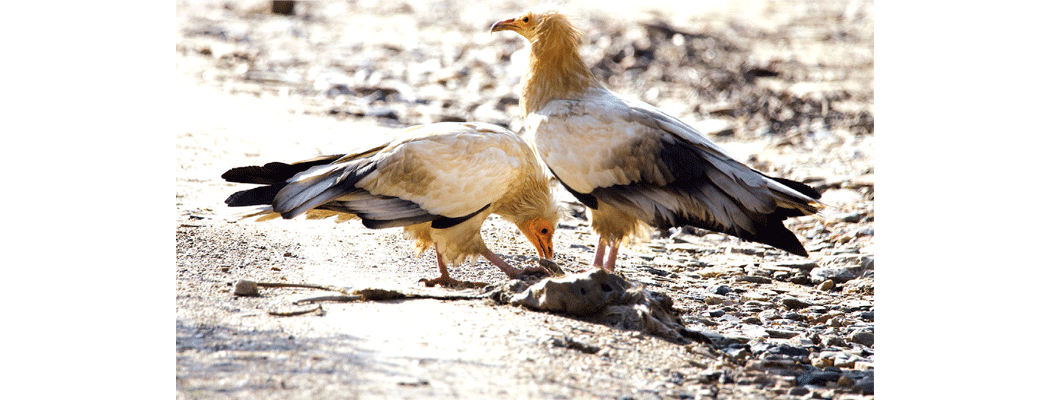- Thursday, 11 December 2025
Egyptian vulture witnessing population decline
Kathmandu, Feb. 25: Egyptian vulture, locally known as “Seto Giddha” in Nepali is facing population decline due to habitat loss, diclofenac poisoning, destruction of nesting habitat, persecution, and other human-induced disturbances.
As all the vultures feed only on carcasses, they are called nature scavengers.
The Egyptian vulture (Neophron percnopterus), also known as an old-world vulture and a long-lived scavenger, has been facing risks because of electrical infrastructure, trade of traditional medicines and lack of food as well as secondary poisoning associated with the livestock drug diclofenac.
The vulture, once widespread across Asia and Africa, has critically been endangered because of habitat loss and killing.
In Nepal, a team of wildlife conservationists has been working tirelessly to protect the Egyptian vultures and their habitat.
According to Dr. Hem Sagar Baral, a noted ornithologist, the vulture is the smallest in size compared to eight other species found in Nepal. They nest in cliff and tall trees and can lay two eggs at a time while the other species lay only one egg at a time.
These Egyptian vulture is different from other vultures. Their beak is slender and hook-shaped, adapted for removing meat from carcasses. Their diets are diverse and they include carrion, tortoises, organic waste, insects, young vertebrates, eggs, and feces, Dr. Baral said. These vultures are mostly found in the Pokhara-Tanahu landscape, he added. They look dark brown when they are young but change their appearance and become black and white when they become adults, he added.
They are solitary nesters and monogamous, with a breeding season from February to May. They generally use the same nest each year, constructed on cliffs and rocky outcrops, but occasionally nest in large trees and utility poles.
According to a recently published report entitled “Factors Influencing the Potential Distribution of Globally Endangered Egyptian Vulture Nesting Habitat in Nepal”, these birds perform numerous beneficial activities including scavenging. They remove carcasses and can control the spread of disease. However, many vulture species are under threat globally.
A monitoring of nesting status of Egyptian Vulture in Argha IBA (Important Bird and Biodiversity Area), Arghakhanchi, from 2010 to 2020 shows its nests increase from four to eight, according to Krishna Bhusal, member, IUCN SSC Bird Red List Authority.
The habitat suitability is crucial to ensure the long-term persistence of the species and can be identified based on relationships between species occurrences and underlying abiotic and biotic factors, Bhusal said.
After identifying potentially suitable habitats, the research team identified environmental factors affecting landscape-level and suitable nesting habitat for the Egyptian vultures using generalised linear models. For these vultures, sites near forests and human settlements were found to be most suitable for nesting, roosting, and foraging, especially in central and western Nepal.
Based on potentially suitable nesting habitat and previous work on this bird’s foraging and roosting habitat, we recommend protecting forests near water sources and open areas for their long-term conservation, read the report.
“We are anticipating tracking of the Egyptian vulture movement with satellite tags in future and an in-depth study on the potential food toxicity of garbage which is their popular foraging site,” Bhusal added.
The European population of Egyptian Vulture is well studied and they are largely migratory but the Asian population is not studied yet. So, this study identified the potential nesting sites and we will prioritise visiting those sites for the exploration, Ankit Bilash Joshi, Vulture Conservation Programme Manager at Bird Conservation Nepal (BCN), said.
Widely distributed species native to Asia, Africa, and Europe, they are categorised as endangered by the IUCN Red List of Threatened Species. Their global population is estimated at 12,400 to 36,000 individuals in the wild.
In Nepal, vultures are currently threatened from forest degradation due to forest resource extraction and disturbances to breeding, roosting, and feeding habitat, Dr. Baral said.
Consequently, the government of Nepal developed a Vulture Conservation Action Plan in 2009 to prevent the potential loss of vultures through the establishment of vulture safe-feeding sites and strengthening vulture-safe zones for providing diclofenac and poison-free carcasses. However, little information is available on suitable habitats for this species of vulture in Nepal, including nesting habitats.
















